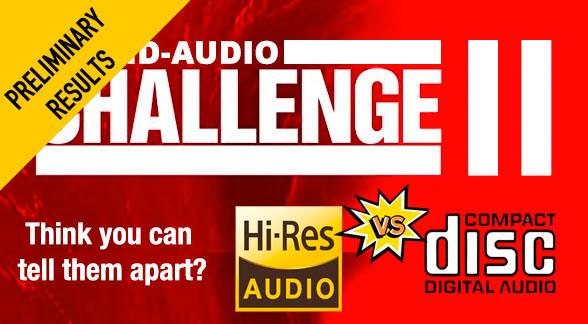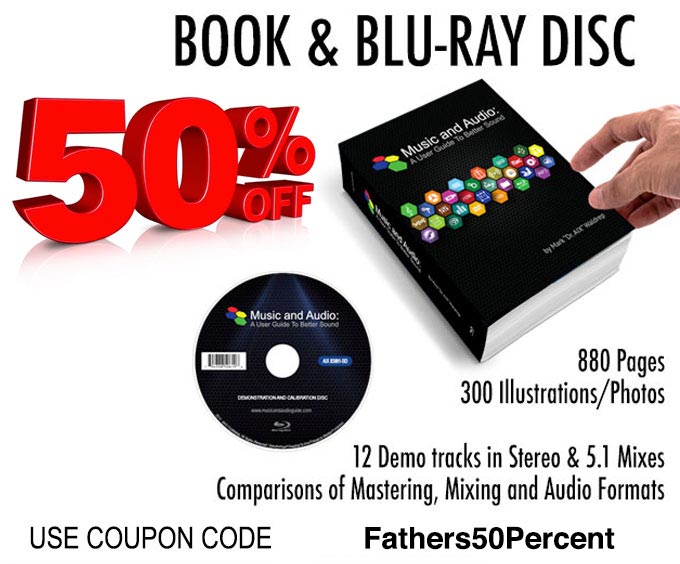Researching HD-Audio: The Truth
It’s finished. The HD-Audio Challenge II, my sabbatical research project from last fall, has run its course. It’s time to start presenting the data and the analysis associated with almost 500 responses. Among those that submitted their results were audiophiles, casual listeners — both young and old, as well as a few professional audio engineers. And while the age of the participants skewed higher than desired and are predominantly male, the truth is that audiophiles tend to be older men. We’re the target group that is supposed to care about fidelity. But with Amazon Music HD and other “so-called Hi-Res Audio” streaming and download sites marketing to ALL music listeners, HD-Audio trying to be ubiquitous. But is HD-Audio really sound better or is it merely a sale gimmick?

That’s what the study was supposed to help determine. Here’s the question: Would average music listeners be able to pick out a hi-res audio track over a Red Book standard CD version of the same master recordings using their own playback systems? Paul MacGowan of PS Audio said, “Oh God yeah” in one of his videos. My research survey, conducted over these last 8 months, arrives at a different conclusion. Hi-Res Audio or HD-Audio provides no perceptible fidelity improvement over a standard-resolution CD or file. CD-spec and hi-res audio versions sound identical to vast majority of listeners through systems of all kinds. I’ll present the track by track breakdown over the next few articles, but the responses present a picture that is undeniable. In fact, over 25% of the listeners that submitted their results indicated “No Choice” when asked to pick the hi-res track. People were honest and acknowledged that they could not tell the two different versions apart. And those that made a selection admitted that it “was virtually impossible” to detect any differences or “they were essentially guessing” which was which.
Hi-Res Audio or HD-Audio provides no perceptible fidelity improvement over a standard-resolution CD or file.
Outcome of the HD-Audio Challenge II – Mark Waldrep
So it’s time to face the hard facts IMHO. Hi-Res Audio or HD-Audio, the much touted next generation in music fidelity, should NOT be a major determining factor when selecting which music to enjoy. As I’ve often stated in these articles, it is the production path that establishes the fidelity of the final master. Things like how a track was recorded, what processing was applied during recording and mixing, and how the tracks were ultimately mastered. If all of these things are done with maximizing fidelity as the primary goal, a great track will result. However, it’s very easy to destroy fidelity at any number of steps in the process.
Since the introduction of high-resolution digital methods for recording and reproducing audio emerged in the 1980s and practical distribution formats launched in the late 1990s, research has been conducted to determine whether and why “hi-res audio” is better than existing delivery standards. One of the most well-known among them was the 2007 AES paper authored by Meyer and Moran titled, “Audibility of a CD-Standard A/D/A Loop Inserted into High-Resolution Audio Playback”, which concluded that “… test results show that the CD-quality A/D/A loop was undetectable at normal-to-loud listening levels, by any of the subjects, on any of the playback systems.” Basically, what the researchers did was play a commercially distributed “hi-res audio” SACD (one was a DVD-Audio disc) directly through a very good stereo playback system and then through an A/D/A conversion chain running at Red Book specifications 44.1 kHz/16-bits. None of the listeners, which included “professional recording engineers, students in a university recording program, and dedicated audiophiles,” could perceive any differences. Sounds pretty convincing, right?
When I first encountered the Meyer and Moran study in the AES Journal, I faulted their process and paid only cursory attention to the conclusion. I believed that it was critically important to point out the fact that the researchers did not verify that the recordings they played during their study exceeded the fidelity of a compact disc! They assumed that the “hi-res audio” SACD albums being released by the record labels possessed greater fidelity than the previous CD versions. But they didn’t. They couldn’t since they were made using analog tape technology. So how is anyone supposed to hear a difference if both versions are identical? When released on the new SACD format, the fidelity of the mostly analog-based tracks — analog provenance — were not even up to Red Book standards.
I was not alone in dismissing the Meyer and Moran study. In 2007, I was convinced that high-resolution recording — real HD-Audio — would be perceptible. I recognized the shortcomings of their research and have written extensively about the important of “provenance.” If the original master of an album or track was produced prior to the introduction of high-resolution recording equipment, then it is impossible for that album or track to be considered “hi-res audio” in spite of the best marketing efforts of the labels and others.
So after carrying out my own research project, I am forced to agree with the conclusion of the Meyer and Moran research. I’m sure that I will become the target of similar criticism. Someone will insist that my files were’t typical, weren’t properly processed from 96 to 44.1 kHz, or that participants could have cheated when listening or submitting their results.
Additionally, the guru behind MQA — Robert Stuart — wrote in another AES paper, “… there exist audible signals that cannot be encoded transparently by a standard CD; and second, an audio chain used for such experiments must be capable of high-fidelity reproduction.” His position is untenable if the results of my survey are true. If real world audiophiles cannot hear a difference then there is no audible difference.
More to follow but I’ll leave you with another short MQA related item. In a previous article, I explained yet again why MQA is a hoax and not worthy of support by listeners and equipment manufacturers. In fact like hi-res audio, it is a marketing ploy designed to enrich its stake holders. You can read the article by clicking here. I received an email from a reader noting that the entire section of my piece was lifted by a member of a FB group and posted as a comment on their group without attribution of any kind. They omitted my name and there was not link to the original article. It did raise a great deal of controversy and there were lots of comments. MQA is a hot topic.
In order to read the post, I have to request and receive permission from the administrators to join the group, which was granted. So I wrote to the administrator:
“This is Mark Waldrep. I was informed by one of my blog readers that one of my recent posts about MQA was lifted wholesale from my blog and posted on your FB group…without attribution or a link back to my site. I find this somewhat disturbing and hope that you can ensure that your members respect the work of others. I am happy to contribute to your discussions and even allow quotes from my blog, but this was excessive. Regards, Mark”
I received the following responses from ORCHUN CAGLIAN, one of the groups administrators:
“I’m removing you from the group I also removed the post and the member too Dont contact me with an attitude again I dont want people like you in my groups.” (This is copied from his response … the lack of punctuation is his.)
Frankly, I was surprised at the response. It confirmed to me that some FB admins aren’t worth supporting.
Fourth of July Specials
This is the 4th of July! I’m offering a 50% discount on physical copies of the Music and Audio book. Now is the perfect time to read what has been called, “the gold standard” in audio reference books. Use coupon code “Fourth50Percent” at check out.

Streaming, Download, and Personal Audio – The New Book Is Coming
I’ve been spending a couple of hours everyday writing the new book — A Users Guide to Streaming, Downloads, and Personal Audio. Please visit the COMING SOON page and sign up for special discounts and early notification of the Kickstarter campaign. I expect to launch the campaign in the next few weeks.

iTrax.com is growing…and working!
The iTrax.com digital download site is growing everyday. I added another terrific Zenph piano recreation this week. This time it is the Rachmaninoff Plays Rachmaninoff.



I just received and have started reading “Music and Audio.” It looks like a fantastic book and should be required reading for every audiophile or would-be audiophile. It will save many people thousands of dollars in unnecessary expenditures.
I’m also looking forward to your streaming guide. If there are no multichannel streaming services, there should be. Perhaps we need to start lobbying these services to add multichannel recordings.
Thanks for the kind words about the book. I’m excited at the progress on the second one. And yes, a surround streaming service would be amazing. I understand the TIDAL offers Atmos music streams but I haven’t checked it out yet.
I contacted Primephonic, the classical steaming service to ask whether they have any multichannel surround recordings, noting that there are possibly thousands available. Here’s the reply:
At this moment in time we only offer stereo recordings!
As you probably know, Primephonic launched less than two years ago and we still don’t have the resources to focus on multiple features at the same time. Our team is made of about 50 people only and we, unfortunately, need to prioritise and decide what to work on first. Prioritising is very important for our future development and your support is crucial!
I definitely took note of your request and I hope we’ll be able to work on it soon.
Immersive music is gaining marketshare and eventually streaming services will move into surround streaming.
Mark, your Certificate of Heresy is now complete and in the mail.
Hi Mark,
Thankyou.
This is important work and though by your own admission is somewhat confined to a more ‘mature’ audiophile group represents credible data to support the assertion that we are not reaping any benefit from PCM digital audio that we can purchase at greater than 44.1/16bit.
Are you planing to advise which versions of the tracks were which? I am keen to see how badly I did.
I will be presenting each track with a breakdown of the information. I’ll also send your individual results to you (and anyone else that requests it).
Mark,
While I think your conclusion is stated properly, I think it needs to be reasserted. The average person cannot tell the difference. That does not mean there are not people who can tell the difference, just that statistically the average person cannot.
Robert, you’re absolutely right. There were a very few individuals that did very well selecting the HD-Audio versions. And some tracks seemed to have higher “HD” qualities. But the fundamental question remains. Is HD-Audio the “dramatic” improvement that the industry is claiming…in broad strokes…no.
This is to be expected. When there are many options to choose from and many participants, statistically it’s to be expected that some participants would get many correct responses and some songs would be more “popular” than others, even if every single song had been the same throughout the test so it would be pure guesswork.
I’m sure that some of the readers who know a lot about statistics would be able to give you numbers for those scenarios, but at least one scenario I’ve calculated is the likelihood that one person got every single identification correct:
20 squared (20 options, 2 identification options for every song) = 400. If I’m not mistaken there were 21 songs, but one song was repeated.
So if 400 people submit their choices, 1 person should be expected to get them all right.
Do you think that the small number of individuals who could discern the HD audio might have been people who didn’t take the admonition to not do an analysis on the file to look for frequencies beyond the audible range? The way you conducted the test, you can’t guarantee that some individuals didn’t cheat, and they would all fall on the side of being able to discern the high data rate audio.
Honestly, I believe that people did not cheat. I have been in contact with a number of the individuals that did very well on the survey _ including a couple that got 100%. I inquired about their methodology. One was a student of mine. He loaded the files into Pro Tools (a widely used DAW) and was able to quickly A | B switch between them. He used headphones, had the volume turned up, and examined the quietest moments listening for noise levels etc. His method seemed to work but doesn’t really represent the listening reality of most audiophiles. Most of those that did better than chance observed that it was very difficult to tell them apart and lacked a high degree of confidence. Perhaps I’m too trusting but I think the survey represents an accurate reflection of the state of high-res music.
Hi Mark
The audio community, particularly consumers, would be in a much better state of all producers, labels and hardware manufacturers were as honest as you are. I noted that years ago you did believe hi res audio was a noticeable improvement over CD 16/44. Then you doubted that earlier belief with your own tests and now you have gone a big step further by inviting others to take part in a listening test and you honestly presented the results and your conclusions. Some may say that you may be crazy given your business model of hi res recordings but if anything, apart from demonstration your ethical conduct, it demonstrates that it is your skills and experience in recording and mastering which makes your material sound great.
Mark
Just regarding your comments on the Meyer and Moran study. I agree that the test was somewhat invalidated because the provenance of the SACDs and DVD audio discs were not checked. However one benefit of that test was that it demonstrated the results in a somewhat different manner. You see for nearly 10 years up to that test those SACDs and DVD discs were sold all around the world and yet no-one noticed that they were no better than CDs, no home audiophile and not one golden eared reviewer. In the end the provenance was established by testing rather than listening. It clearly demonstrates the power of expectation biases and probably the reason why DAPs and streamers have a light or some sort of indicator to show that a hi res file is being played – if it was such a difference why would such an indicator be needed? The Pono player (remember that) could let the listener choose between hi res and CD quality to hear the difference but it did not do that blind so the listener had to do it unsighted.
So given the results, given the time you’ve spent doing this and other tests, will you now and in the future record at 48/24 or 44.1/24?
No. It is important and beneficial to record using 96 kH/24-bits when the musicians are performing. It provides better margins for overloads and minimizes distortion. The distribution of those masters could be at hi-res or standard resolution.
While I am happy to buy Hi-Res downloads, particularly when they are no more expensive than CD, I am amused to remember how much I enjoyed my original Mission DAD 7000 CD player, and all of the 14 bits of resolution it decoded.
I’m not seeing comments all of a sudden.